
The Redington Museum or Redington House is a historic house and museum in Waterville, Maine that is listed on the National Register of Historic Places. The museum is the headquarters of the Waterville Historical Society. Built in 1814, it is one of the best-preserved houses of the period in the city. It has served since 1924 as the museum and headquarters of the Waterville Historical Society, and was listed on the National Register of Historic Places in 1978.
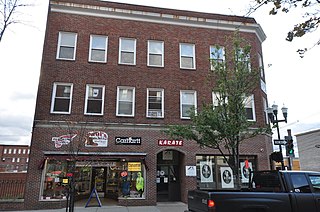
The Lower Lisbon Street Historic District encompasses part of the earliest commercial center of Lewiston, Maine. Located on the west side of Lisbon Street, the city's main commercial area, between Cedar and Chestnut Streets are a collection of commercial buildings representing a cross section of architectural styles, built between 1850 and 1950. When the historic district was listed on the National Register of Historic Places in 1985, it included 18 buildings. Eleven of these have since been demolished, and one has a significantly altered facade.

The Central Square Historic District is a historic district encompassing the central town common of the city of Waltham, Massachusetts, and several commercial buildings facing the common or in its immediate vicinity. The common is bounded by Carter, Moody, Main, and Elm Streets; the district includes fourteen buildings, which are located on Main, Elm, Lexington, and Church Streets, on the north and east side of the common. The district was listed on the National Register of Historic Places in 1989.

The Main Street Historic District encompasses the historic commercial center of Damariscotta, Maine. Although the community was settled in the 18th century, most of its downtown area dates to the second half of the 19th century due to an 1845 fire. Lining Main Street east of the Damariscotta River, the downtown has a well-preserved collection of commercial, residential, and civic structures from the period. The district was added to the National Register of Historic Places in 1979, and enlarged in 2001.

The Downtown Adrian Commercial Historic District is a historic district comprising the downtown area of Adrian, Michigan. It was designated as a Michigan Historic Site and added to the National Register of Historic Places on April 17, 1986. The district is roughly bounded on the north by Toledo Street, on the east by North Broad Street, on the south by East Church Street, and on the west by North Winter Street (M-52), West Maumee Street, and the River Raisin. Most of the district is enclosed by the US-223 Business Route, although the two are not conterminous.

The Downtown Waterbury Historic District is the core of the city of Waterbury, Connecticut, United States. It is a roughly rectangular area centered on West Main Street and Waterbury Green, the remnant of the original town commons, which has been called "one of the most attractive downtown parks in New England."
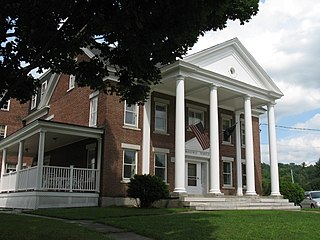
The Barre Downtown Historic District encompasses the historic commercial and civic heart of the city of Barre, Vermont. Extending along Main Street from City Park to Depot Square, this area was developed quite rapidly in the 1880s and 1890s, when the area experienced rapid growth due to the expansion of the nearby granite quarries. It was listed on the National Register of Historic Places in 1979.

Biddeford Main Street Historic District is an historic district in downtown Biddeford, Maine. It encompasses the heart of the city's civic and commercial business district, extending along Main and Water Streets between Pike and Elm Streets, extending for short distances along several side streets. It is noted for its collection of late 19th and early 20th century commercial brick and masonry architecture. The district was added to the National Register of Historic Places in 2009.
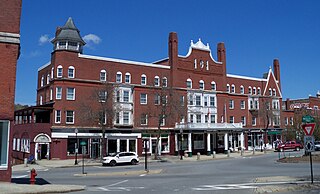
The Central Business District of Claremont, New Hampshire, is centered on Broad Street Park and the Claremont Opera House, and the area between the park and the Sugar River, whose power was responsible for Claremont's growth in the 19th century. The district was listed on the National Register of Historic Places in 1978.

The Calais Historic District encompasses a city block of 19th-century commercial buildings in the center of Calais, Maine. The district, developed after a fire devastated the area in 1870, contains a cohesive concentration of brick Italianate architecture. The district was listed on the National Register of Historic Places in 1978.
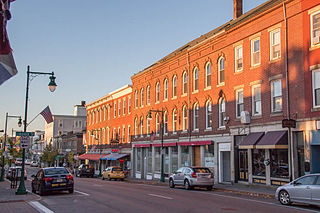
The Main Street Historic District encompasses the historic commercial heart of Rockland, Maine. Located on several blocks of Main Street, the district has a well-preserved collection of commercial architecture dating from the mid-19th to early 20th centuries, the period of the city's height as a shipbuilding and industrial lime processing center. The district was listed on the National Register of Historic Places in 1978, and enlarged in 2012.

The Gardiner Historic District encompasses the historic 19th-century commercial heart of the city of Gardiner, Maine. Once a leading port and industrial center on the Kennebec River, Gardiner's Water Street downtown area retains the feel of its late 19th-century commercial success. It was listed on the National Register of Historic Places in 1980.
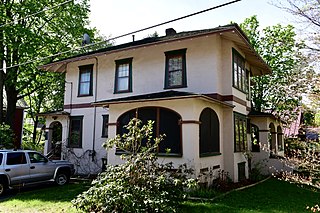
The Heald House is a historic house at 19 West Street in Waterville, Maine. Built in 1916 to a design by Herbert E. Knapp, it is the city's only substantial example of Prairie School architecture. It was listed on the National Register of Historic Places in 2005.

The Richmond Historic District encompasses the historic village center of Richmond, Maine. Established in the 17th century, the town reached its height of prosperity in the 19th century as a major shipbuilding center on the Kennebec River. The district was listed on the National Register of Historic Places in 1973.
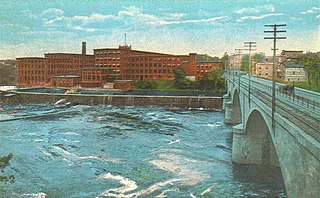
The Lockwood Mill Historic District encompasses the only major 19th-century mill complex in Waterville, Maine. Located south of the city's downtown, it was designed by Amos D. Lockwood, a nationally known industrial designer of the period. Its #2 building was for 45 years home to the Hathaway Shirt Company. It was listed on the National Register of Historic Places in 2007.

The Professional Building is a historic commercial building at 177-179 Main Street in Waterville, Maine. Built in 1923 to a design by Miller & Mayo of Portland, it is a rare early example of Art Deco architecture in the state. It was listed on the National Register of Historic Places in 1982.

The Old Waterville High School, also known historically as the Gilman Street School, is a former school building at 21 Gilman Street in Waterville, Maine. Opened in 1912 and enlarged in the 1930s with Works Progress Administration funding, it is locally distinctive for its Collegiate Gothic and Art Deco architecture, and for its importance to the city's education system. The building, now converted to residences, was listed on the National Register of Historic Places in 2010.

The Waterville Opera House and City Hall is a historic civic building at Castonguay Square in downtown Waterville, Maine. Built at the turn of the 20th century, it is one of a small number of multifunction civic buildings, housing both a live performance venue and municipal facilities, functions it continues to perform today. It was listed on the National Register of Historic Places in 1976.

The City Hall Park Historic District encompasses one of the central economic, civic, and public spaces of the city of Burlington, Vermont. Centered on City Hall Park, the area's architecture encapsulates the city's development from a frontier town to an urban commercial center. The district was listed on the National Register of Historic Places in 1983.

The Howell Downtown Historic District is a primarily commercial historic district located along five blocks of Grand River Avenue in the center of Howell, Michigan. It was listed on the National Register of Historic Places in 1987.






















